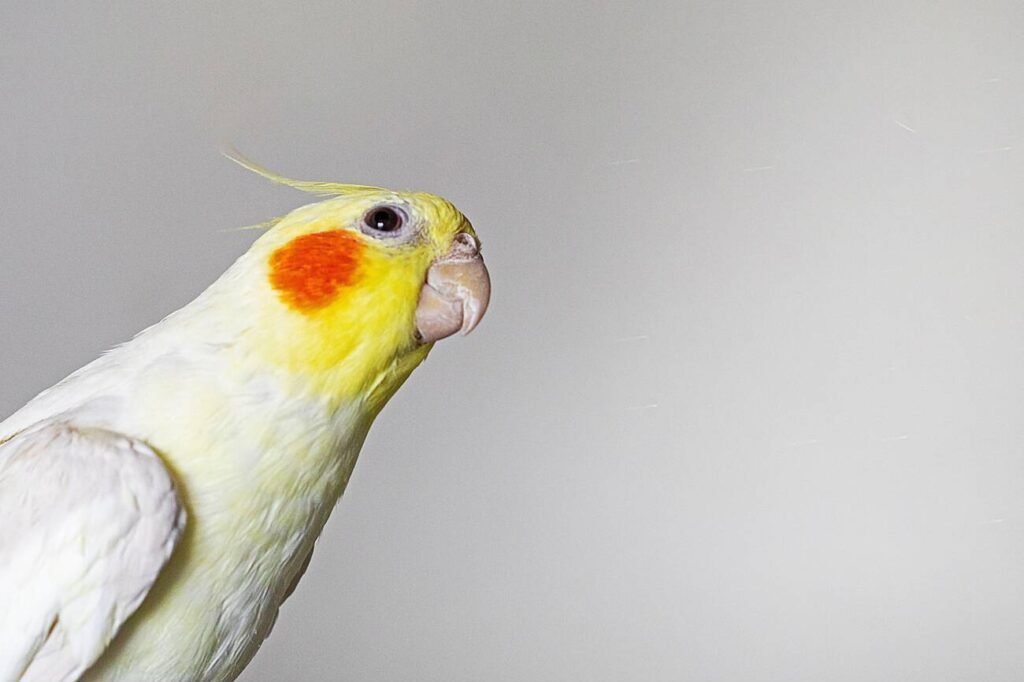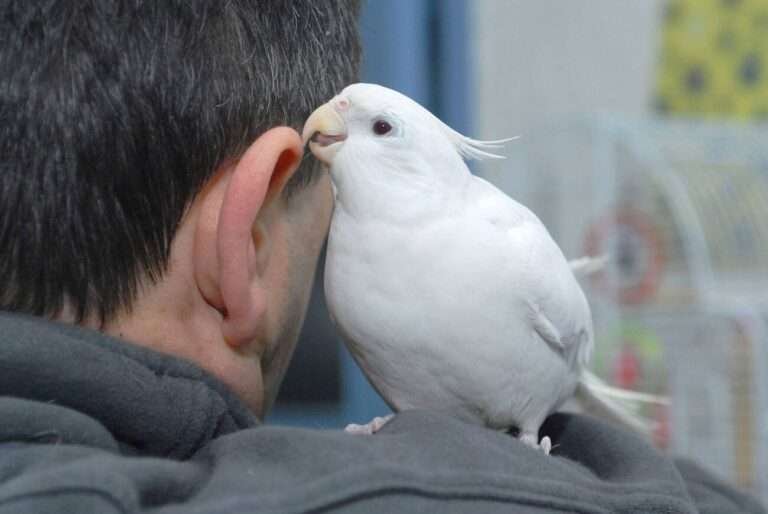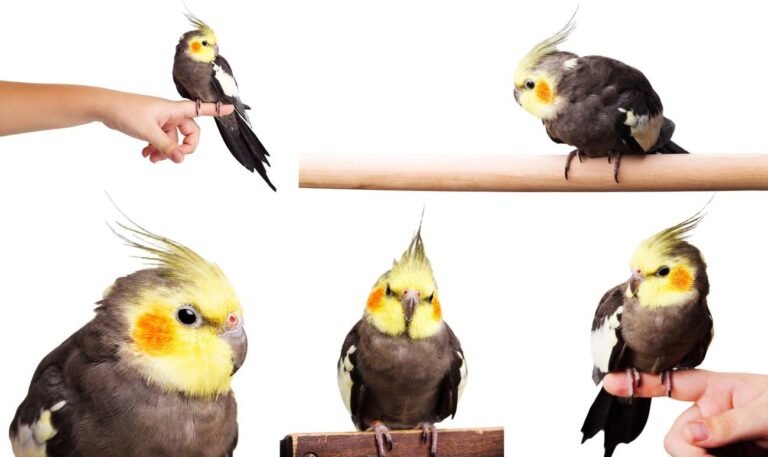The Meaning of Different Cockatiel Bird Sounds

Introduction
As a cockatiel owner with a large flock in my home, I’ve gathered plenty of knowledge and experience in understanding their behaviors, especially their vocalizations. However, this wasn’t always the case. In the beginning, when I started breeding cockatiels, I found it difficult to interpret the various sounds they made. But over time, I learned that cockatiel sounds mean a lot more than just noise — they serve as their primary way of communicating with us and their fellow birds.
For anyone starting their cockatiel journey, understanding the different sounds and their meanings can be a game-changer. In today’s blog, which is beginner-friendly, I’ll discuss the various sounds cockatiels make, what they signify, and why these vocalizations are essential for both the bird and the caregiver. Whether you’re new to cockatiels or already have a few in your care, understanding these sounds can deepen your bond with your feathered companions.
Understanding Cockatiel Communication: A Sound-Filled World
Cockatiels are colorful and lively birds, cherished by bird enthusiasts worldwide. They communicate through a variety of vocalizations, each carrying specific meanings and emotions. Some sounds express joy, while others indicate stress, discomfort, or curiosity. Knowing the differences will help you better care for your birds and meet their needs.
Beak Grinding: A Sign of Contentment
One of the most soothing sounds a cockatiel can make is the gentle grinding of its beak. This sound is similar to a cat’s purring and serves as an indicator of relaxation. Cockatiels often produce this noise when they are settling down for a nap or when they are perched comfortably in a favorite spot. Beak grinding is a clear signal that your bird feels safe and secure in its environment. If you hear this sound, it’s a good indication that your cockatiel is happy and comfortable in your care.
When Will You Hear Beak Grinding?
- During rest or sleep
- When perched in a familiar, safe spot
- In quiet and peaceful environments
Flock Calling: A Call for Companionship
Cockatiels are social creatures by nature, whether they are living in the wild or as pets. One of the most common sounds you’ll hear is flock calling, a vocalization used to maintain connections with other birds. In a flock, cockatiels use these calls to locate and stay close to each other, ensuring the group remains cohesive.
In a home setting, you might notice your cockatiel making this sound when it’s alone in a room or feels separated from you. The sound is often a repetitive chirp or whistle, signaling the bird’s desire for companionship or attention.
Why Do Cockatiels Flock Call?
- To maintain social bonds with other birds in the flock
- To seek interaction from their human caregivers
- When feeling isolated or lonely
Baby Noises: A Cry for Care
Young cockatiels, like many baby birds, make soft, high-pitched chirps when they are in need of attention or care. These baby noises serve as a signal to their caregivers that they require food, warmth, or comfort. As a cockatiel owner, you must be attentive to these calls, especially if you are hand-rearing chicks.
Responding promptly to baby noises fosters trust and security in the young bird, helping it grow into a well-adjusted adult. These sounds are crucial for their development, and ignoring them could lead to stress or health issues.
Common Situations When Baby Noises Occur:
- When chicks are hungry or need feeding
- When they are cold and seeking warmth
- When they feel insecure or scared
Misconceptions About Cockatiel Sounds
Cockatiel vocalizations can sometimes be misunderstood, leading to misconceptions about their behavior. For example, a bird that chirps loudly might be mistaken for being in distress, when in reality, it may just be seeking attention or vocalizing excitement.
It’s important for new cockatiel owners to learn how to distinguish between normal sounds and those that signal distress. Observing body language and understanding the context in which the sound is made can help you interpret your bird’s vocalizations more accurately.
How to Avoid Misinterpreting Cockatiel Sounds:
- Observe the bird’s overall demeanor along with the sound.
- Pay attention to body language like raised crests, fluffed feathers, or wing stretching.
- Be mindful of the surrounding environment to understand if external factors are causing distress or excitement.
Tongue Clicking: Curiosity and Exploration
A unique sound that cockatiels often make is tongue clicking. This sound is created by the rapid movement of the tongue against the roof of the mouth, often accompanied by head bobbing. Cockatiels typically click their tongues when they are curious or excited about something new in their environment.
You might hear this sound when your bird is exploring a new toy, interacting with you, or investigating a new object in its surroundings. Tongue clicking is generally a positive sound, indicating that your cockatiel is engaged and interested in what’s happening around them.
When Do Cockatiels Click Their Tongues?
- During playtime or exploration
- When interacting with new toys or objects
- When curious about their surroundings or other birds
Singing: A Joyful Melody
Cockatiels are natural songbirds, and one of their most endearing traits is their ability to sing and whistle. Males, in particular, are known for their melodious tunes, which they use to assert dominance, express joy, or attract mates during breeding season. However, females can also sing, though their songs are often quieter and less elaborate.
Cockatiels can learn to mimic familiar tunes, household noises, or even phrases if they are exposed to them regularly. Their singing is a form of self-expression, and a happy, healthy cockatiel will often sing throughout the day.
Why Do Cockatiels Sing?
- To express happiness or contentment
- To entertain themselves or their owners
- To attract mates during the breeding season
- As part of territorial or social behavior
Barking: Mimicking Other Animals
It may come as a surprise, but some cockatiels are capable of mimicking the sounds of other animals, such as dogs. This behavior is not very common, but it demonstrates the impressive vocal mimicry ability of these birds. Cockatiels that are exposed to dogs or other animals may start barking as part of their vocal repertoire.
While this might be amusing to bird owners, it also highlights the importance of controlling the sounds cockatiels are exposed to, as they are prone to picking up and mimicking repetitive noises from their environment.
Why Might a Cockatiel Bark?
- To mimic sounds they hear frequently in their environment
- As a form of play or self-expression
- To interact with other animals or humans in the household
Rocking and Hissing: Signs of Stress or Discomfort
Sometimes, cockatiels exhibit behaviors that indicate fear or discomfort, such as rocking or hissing. Rocking involves the bird rhythmically swaying its body from side to side, while hissing is characterized by sharp exhalations of air. These behaviors usually indicate that the cockatiel is feeling stressed, threatened, or overwhelmed by its surroundings.
Hissing is often accompanied by defensive body language, such as fluffed-up feathers or an arched posture. If you notice your cockatiel displaying these signs, it’s important to identify and remove the source of stress to help them feel safe and secure again.
When Might a Cockatiel Rock or Hiss?
- When feeling threatened or scared
- When introduced to a new or overwhelming environment
- During interactions with other birds or animals that are perceived as threats
Mating Calls: The Language of Attraction
During the breeding season, male cockatiels become especially vocal as they attempt to attract a mate. These mating calls are typically loud, repetitive whistles or trills, often accompanied by elaborate body movements such as head bobbing, wing flapping, or tail fanning.
Females, in response, may emit softer, more subtle sounds to indicate their interest. The back-and-forth vocalizations between males and females form a duet of sorts, helping to establish a bond and initiate the breeding process.
Mating Call Characteristics:
- Males: Loud, repetitive whistles and vocal displays
- Females: Softer, more subdued chirps or calls in response
- Often accompanied by physical displays like head bobbing or wing flapping
Chatting: Mimicking Human Speech
One of the most delightful aspects of owning a cockatiel is their ability to mimic human speech. While they are not as proficient as larger parrots like African greys, cockatiels can still learn to imitate words, phrases, or even sentences if they hear them frequently enough.
This ability to “chat” with their owners is a reflection of their intelligence and social nature. Cockatiels that have been taught to speak will often engage in playful conversations, repeating words and phrases back to their caregivers. This interaction strengthens the bond between bird and owner, making them even more beloved pets.
Why Do Cockatiels Mimic Speech?
- To engage with their human caregivers
- To entertain themselves or their owners
- As a form of social bonding and interaction
Hungry Baby Cockatiel: A Call for Nourishment
One of the most heart-wrenching sounds any cockatiel owner can hear is the persistent chirping of a hungry baby cockatiel. These cries are unmistakable and serve as a clear indication that the young bird is hungry and needs immediate nourishment. The high-pitched, insistent chirping is designed to grab the attention of its caregiver or parent, signaling that it’s time to eat.
If you’re hand-feeding baby cockatiels, these cries will become a familiar sound. Responding promptly to a hungry chick’s call is crucial, as young birds need frequent feeding to support their rapid growth and development. Ignoring these cries could result in malnutrition, so it’s vital to establish a regular feeding routine that meets the chicks’ nutritional needs.
When Do Baby Cockatiels Cry for Food?
- When they are hungry and ready to be fed
- When they feel cold and need comfort
- When seeking attention from their parents or caregivers
How to Respond to Hungry Baby Cockatiels
- Feed them immediately with a nutritious diet appropriate for their age
- Keep the brooder or nest box warm to ensure their comfort
- Offer regular feeding intervals to avoid hunger-induced stress
Whining or Screeching: Signs of Discomfort
Cockatiels are not shy about expressing their discomfort, and one of the ways they do this is through whining or screeching. These sounds are often sharp, high-pitched, and repetitive. They can indicate a range of issues, from minor annoyances to significant distress. For example, a cockatiel might screech if it’s feeling bored, lonely, or frightened, or if there’s something physically wrong, like illness or injury.
It’s essential to pay close attention to the context in which these sounds occur. If your bird is screeching excessively and you can’t pinpoint the cause, it might be a sign that something is wrong and warrants a closer inspection of their health, environment, or emotional state.
Why Might a Cockatiel Whine or Screech?
- Feeling neglected or wanting attention
- Boredom from a lack of stimulation or toys
- Illness or physical discomfort
- Environmental stressors like noise, temperature, or changes in their surroundings
Responding to Screeching Cockatiels
- Ensure they have enough mental stimulation through toys and interaction
- Check for potential health issues by consulting an avian vet
- Remove any environmental stressors that may be causing the discomfort
Silence: When No Sound is a Sign
While cockatiels are generally vocal birds, silence can sometimes be just as telling as any of their sounds. A quiet cockatiel might be content and relaxed, but prolonged silence can also indicate illness, injury, or depression. If a usually vocal bird suddenly stops making noise, it’s important to assess their overall health and well-being.
This change in behavior could be a sign of something more serious, such as respiratory illness, feather plucking, or emotional distress due to changes in their environment or lack of social interaction. Monitoring their behavior and consulting an avian vet if the silence persists is essential to ensure their health.
When Should You Worry About a Silent Cockatiel?
- If the silence is sudden and unexplained
- If accompanied by lethargy or changes in eating habits
- If your bird shows physical signs of illness (fluffed-up feathers, wheezing, etc.)
Conclusion: Understanding the Language of Cockatiels
The vocalizations of cockatiels offer a fascinating insight into their emotions, needs, and interactions with their environment. Each sound they make, from the soothing beak grinding to the high-pitched cries of a hungry chick, serves a specific purpose in their complex communication system. By learning to recognize and interpret these sounds, bird owners can forge deeper connections with their cockatiels, ensuring they are healthy, happy, and well-cared for.
As a beginner, it’s important to be patient and observant. Over time, you’ll come to understand the subtle nuances of your cockatiel’s sounds and what they mean. Whether it’s the joyful melodies of a singing cockatiel, the tender chirps of a baby in need of care, or the warning hiss of a frightened bird, each sound carries with it a wealth of information about your bird’s state of mind and health.
By responding to these vocal cues with empathy and care, you can strengthen the bond with your feathered friend, creating a relationship based on mutual trust and understanding. In doing so, you not only enrich your bird’s life but also enjoy the rewarding experience of sharing your home with one of nature’s most expressive and intelligent creatures.
Understanding the language of cockatiels isn’t just about knowing what sounds they make—it’s about truly listening and caring for them in a way that meets their emotional and physical needs. Whether you’re a seasoned cockatiel owner or just starting your journey, paying attention to their sounds will guide you toward a deeper, more fulfilling relationship with these wonderful birds.



